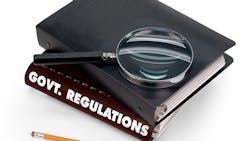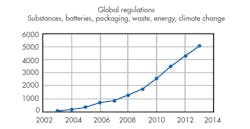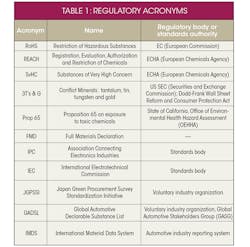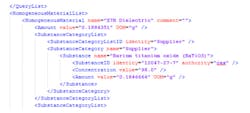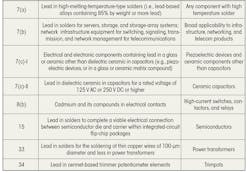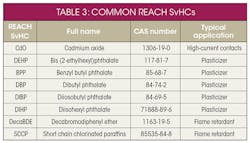Beyond “Lead-Free”: An Update on the IPC-1752A Standard for Materials Declaration
This article is part of the RoHS and Critical Materials in our Series Library.
The IPC, dubbed the “Association Connecting Electronics Industries," is a global trade organization that supports programs to meet the needs of the global electronics industry. One of its efforts has been developing standard practices for meeting global reporting requirements for information about the materials used in electronic products. In part, this effort has been driven by the Restriction of Hazardous Substances Directive (RoHS) and the Waste Electrical and Electronic Equipment Directive (WEEE). However, due to the growing list of substance restrictions on electronics and other consumer products, companies could benefit from a standard reporting format.
This file type includes high resolution graphics and schematics when applicable.
IPC-1752A, the Materials Declaration Management Standard,1 accomplishes that goal. It provides a standardized format for communicating materials in products across the supply chain. This helps companies better manage the ever-increasing need for materials disclosures throughout the supply chain.
A Journey Toward Data Exchange
Over the past 10 years, the number of worldwide substance restrictions on electronics and other consumer products has grown exponentially (Fig. 1). The number of substances on lists like the European Union’s (EU) Registration, Evaluation and Authorization of Chemicals (REACH) Substances of Very High Concern (SvHC) continues to grow as well.
Differing versions of the EU’s Restriction of Hazardous Substances (RoHS) Directive are now in force in several Asian countries; the U.S. is implementing them as well, with Conflict Minerals regulations and California Proposition 65 (Table 1). As a result, electronics companies have, out of necessity, become managers of the material content of their products while continuing to demonstrate breakthroughs in performance and features.
Given this “ocean of global regulatory requirements,”2 it’s no surprise that standardized reporting has been sought by the electronics industry. Indeed, industry groups and standards bodies have stepped in to fill the need for reporting the contents of electronics goods—notably, IEC, IPC, JGPSSI, and the automotive industry’s GADLS and IMDS. Providers of services to support data collection and reporting are on the rise, too.
While compliance is a must-have for companies doing business in regions that apply these regulations, having access to data on the content of products can further support meeting specific customer requirements. It also helps demonstrate conformance to voluntary standards and eco-labels, and leads to support for broader initiatives.
It’s not surprising that one of the key recommendations of the 2010 NIST workshop on sustainable manufacturing was to “support regulations (e.g., RoHS) with industry standards (such as IPC-1752).”3 When considering best practices for the transfer of material and substance data across the supply chain, there’s no doubt that the IPC-1752A standard is emerging as one of them. This view is supported by our own high-volume experience working with a host of suppliers, major customers, and software solutions providers.
Of course, there remain cases where a statement of compliance or yes/no survey fulfills the business need. Custom spreadsheets continue to be used as well, and many companies demand specific forms from their suppliers. Some of these “almost standard” formats for Full Materials Declaration (FMD) align with IPC-1752A or are variations of the Compliance Connect format.4 As a versatile reporting means, IPC-1752A supports several different classes of reporting as needed:
• 1752 - Class A: Declaration Query/Reply
• 1752 - Class B: Material Group Declaration
• 1752 - Class C: Material Composition Summary Declaration - Product Level
• 1752 - Class D: Material Composition Declaration - Homogeneous Material Level
Where is the PDF Form?
When IPC-1752 was first published in 2006, a fillable PDF form accompanied the standard. Many users of the standard asked for the PDF form when downloading its revised version. So where is the PDF form and why is it no longer available?
After revising the 1752 standard in 2010, the developing standards committee decided to rely on third-party solution (software) providers to develop tools (forms in some cases) compatible with the standard rather than the committee developing and maintaining a form. Further, the old PDF form presented a plethora of problems, compounded by Adobe’s inability to support the underlying needs.
IPC-1752A declarations are entirely implemented in XML, or eXtensible Markup Language—an open, non-proprietary language used for years to send data elements and attributes across the Web and between various entities. XML works in a similar way to email. Though there are several email providers, email can be read regardless of the account or provider. The current XML schema resides in IPC-1751A, Generic Requirements for Declaration Process Management. IPC-1751A contains basic demographic, contact, and product information. Therefore, an IPC-1752A declaration must include an IPC-1751A declaration (Fig. 2).
The strength of a standard reporting schema is that data can be generated by a supplier, read by a customer company, and then combined with that company’s data to further report to its customers. Standardization helps with two fundamental needs: what to report (list of substances) as well as how to report (format or schema).
How to Report: Large Company Example
A typical use case for a supplier of materials and components, like TE Connectivity, is to receive requests from customers to provide FMD, which will be a Class D disclosure. These requests may be frequent and consist of sizable lists of part numbers to report. They may be specific to certain business units, require some coordination or sharing of responsibility, or be received and handled by a centralized customer support center.
A Class D FMD requires substance-level data to report substances in each homogenous material to the customer. This data is mandatory, according to the IPC-1751A schema. Passing on the request for FMD’s to the company’s suppliers (technically, the manufacturers) thus becomes an ongoing business activity. Furthermore, the part on which to report may have its own bill of materials (BOM), both at the homogenous material and substances levels, as well as at the company part level if the parent part incorporates other parts. These may be handled nicely by a system that can scale to handle complex BOMs.
Larger companies’ needs are best handled by an enterprise software system; today, one can choose from a wide range of systems and options.5 Given the input of part number and contact information, these systems can quickly generate the XML formatted files according to the schema specified in the IPC standard. While XML is mainly a machine-readable format, some systems may also provide a human-readable form options, such as a spreadsheet or PDF document.
One of the advantages of an enterprise-level system is the ability to input a list of parts, and produce multiple disclosures at a time. Further options include the capability of producing standalone files that are sent directly back to the customer via email or uploaded to an eternal loader, or even publishing the FMD on your company’s website.
When sufficient materials and substance data is available, reporting via IPC-1752A is efficient and works well. Standardized reporting becomes the key in this scenario. Potential enhancements include additional automation of the process to reduce manual preparation of reports, perhaps initiated by a machine-read request and fulfilled through generation of machine-readable reports. Standardization, though, enables a seamless data flow.
One concern involves keeping all data up-to-date, and of course, doing the arithmetic calculations separately for RoHS homogeneous materials and REACH final article substance concentrations. This means that reporting systems are inherently dynamic and may be complex.
While Conflict Minerals management has some commonality with other substance data, the reporting format is significantly different from the intent of IPC-1752A. The applicable standard for this regulation is IPC-1755, Conflict Minerals Data Exchange Standard.1
How to Report: Smaller Company or Service Provider Example
Several options emerge when a dedicated enterprise system isn’t a business requirement. Free online tools may be used to generate IPC-1752A format XML files from direct keyboard entry, text files, or spreadsheets.6 In addition, suppliers of this service will perform data collection and reporting for your company.7 Some overlap does exist between these different solutions and services. The point here, though, is that an IPC-1752A report can be produced in a variety of ways, depending on your business needs and capabilities.
Files conforming to the standard can be output for the customer, as well as serve as inputs. Thus, it fulfills the promise of end-to-end supplier chain substance disclosure.
What to Report
Initially, the IPC reportable substance list focused on RoHS and other substances viewed as potential health or environmental risks. The Joint Industry Guide (JIG) list went through several updates before being discontinued in the latest IPC-1752A standard. The reportable list is now the IEC 62474 database. Since IEC 62474, Material Declaration for Products of and for the Electrotechnical Industry, is also a reporting protocol, efforts are underway to continue to harmonize the IPC and IEC standards to have one combined protocol and reportable substance list.
Nonetheless, while standardization efforts continue, it seems every company has a unique reporting list that’s more finely tuned to its products, end markets, and customer requirements. Some of these lists cover mostly hazardous substances, or those from a selection of various watch lists, while others add substances that might be of value for end-of-life material recovery and recycling. There appears to be no immediate end is in sight to this aspect of the reporting process. As such, difficulties may arise when the source system (supplier) reports substances that are unknown to the destination system (customer).
Solutions to the custom substance list issue include loading the supplier’s list to the customer’s own system, which isn’t a trivial undertaking, or the supplier manually editing the published files to some degree. Unfortunately, this is a reality that many companies throughout the supply chain must continue to address to satisfy customer requirements.
Standards Committee Activities
One of the supporting 175x family standards, IPC-1751A, is being reviewed to harmonize all IPC data-exchange standards with IEC 62474. Work is also underway to include the laboratory declaration standard (IPC-1753) and Conflict Minerals standard (IPC-1755) as part of the IPC-175x family of standards. To do this, IPC-1751A will be revised to include all data fields for all sectional data exchange standards as optional fields, with a few exceptions. Each sectional standard would then identify which fields are applicable and those that are mandatory.
In addition to updates and harmonization efforts for IPC-1752A, the 2-18b Materials Declaration Task Group is diligently working to complete the first round of evaluation of XML declarations by software solution providers. The purpose of this activity is to provide independent, yearly reviews to validate that these reports follow the latest released standard and schema, contain well-formed XML, and follow the latest lists of substance categories and exemptions.
Companies were invited to submit Class C and/or Class D XML reports, based on a file provided by IPC containing test materials and substances, with selected exemptions. Use of third-party tools to check for well-formed XML, and visual inspection of the files, were provided by the task group members. IPC is publishing a list of providers reviewed in the first round of evaluation on its website. Note that this activity is a recognition of review of conformance to the standard, schema, and latest substance lists and exemptions—not a formal certification or validation of tools.
Staying Ahead of Regulations: Even More Reasons for FMD
While a simple statement or certificate of compliance may be adequate today, the best way to stay ahead of additional substance regulations is a Full Materials Declaration. Here the use case is to maintain awareness of what substances are present in your products, even though no current restriction is enforced.
The pending expiration of RoHS exemptions is a compelling example of the benefits of standardized FMD. Table 2 lists selected exemptions relevant to electronics that will expire, or may expire soon depending on whether or not the affected companies win the case for continuance with the EC. For a comprehensive list, including exemptions for lighting and optical applications and more, see IPC-1752A Appendix B.8
Having data on the substances in your products will enable risk assessment of expiring exemptions to your business. Clearly, as highlighted in the table, not only commonly used components, but entire product lines like those for telecom and infrastructure products, could be affected by expiring exemptions.
REACH SvHC lists are updated every six months by ECHA, and soon thereafter incorporated in updated appendices within IPC-1752A. In reality, the only way to stay ahead of the continual growth of restricted substances, without continually collecting more data twice a year, is to require reporting of a proactive substance list from your supply chain. It should contain a future “radar” or “crystal ball” list of substances that could likely appear on the next REACH SvHC list. Unfortunately, standardization in this area isn’t mature yet, and as mentioned, every company seems to maintain its own custom list of reportable substances.
REACH rules are different from RoHS since there are no exemptions, and the REACH SvHC threshold is 0.1% at the article level, unlike the RoHS threshold applied to homogenous materials. Als0, more than one tonne per annum of REACH SvHCs needs to be produced or imported into the EU for action to be required. Because REACH applies to a broader market than just electronics goods, a review of SvHCs versus their use in your own electronics products is recommended. Table 3 provides a relevant short list.
Knowledge of these substances, in order to take appropriate action, is best enabled by collecting FMD throughout the supply chain. This once again highlights the business value of the IPC-1752A standard.
Conclusions and Future Prospects
Standardized substance reporting offers many benefits to a business. When substance data is fully available, with a system in place to generate FMDs on demand, the reporting process becomes very efficient. Suppliers know their customers’ expectations for reporting, and end-customer OEMs gain the benefit of data from the entire supply chain. Intermediate suppliers may use the IPC-1752A for both incoming and outgoing reporting. Intelligence on the content of your products is valuable for assessing risk and taking appropriate action to either report according to regulatory requirements, or take steps to design out substances of concern.
Of course, there’s always room for improvement in data quality and automation. Some of these areas include:
• Ability to generate reports for multiple parts at a time (currently available in some enterprise systems).
• Improved automatic error checking for unlikely data conditions (e.g., multiple RoHS violations in a single part, or exemptions claimed for applications that aren’t suitable for the part).
• Direct B2B request/reply capability, eliminating the need to manually receive requests, generate reports, and distribute.
• Continued harmonization of IPC and IEC standard schema, reportable substance databases and lists, and acceptance by industry of the same.
• Automatic generation of updated declarations when changes occur to part design, BOMs, or any material aspect of the product.
• Automatic publication of disclosures to your company website, facilitating customers or other stakeholders to get the information on demand.
• Scientifically based decisions around substance restrictions.
Read more articles from the RoHS and Critical Materials in our Series Library.
This file type includes high resolution graphics and schematics when applicable.
References:
1. “Data Exchange Standards.”
2. “Navigating the Ocean of Global Regulatory Requirements (Commentary),” CIMdataPLMNews, April 8, 2014.
3.“Sustainable Manufacturing: Metrics, Standards, and Infrastructure,” NIST Workshop Report NISTIR 7683. Sudarsan Rachuri et. al., Eds. April 21, 2010.
4. For information on the Compliance Connect spreadsheet, see “ENOVIA Materials Compliance Supplier Portal.”
5. A partial list of some enterprise compliance systems supporting IPC-1752A reporting that have come to our attention includes (in alphabetical order): Altera Corp. Materials declaration for Enpirion products; Assent Compliance Inc.; ENOVIA Materials Compliance Central; Foresight Compliance Cloud GEMS; GreenSoft Technology Inc. GreenData Manager; PTC Windchill Compliance; SAP product compliance software; and Siemens Teamcenter Regulatory Compliance.
6. Online free tools supporting IPC-1752A XML reporting that have come to our attention include 1752Builder and IPC-1752A Generator.
7. A partial list of providers of data collection and reporting services supporting IPC-1752A format that have come to our attention includes ENVIRON; QPoint Technology GDX; Total Parts Plus; and some of the systems providers listed in reference number 6.
About the Author
Roger L. Franz
Environmental Sustainability Advocate and Contributing Author
Roger Franz has served as Principal, Engineering IT at TE Connectivity, Research Engineer at UL Environment, and Group Leader and Design for Environment Manager at Motorola. In addition to product environmental compliance and standards, his passions include new product development, quality, and technology research. His papers have appeared in several industry journals. He has had over a dozen article published in Electronic Design. He holds a BA and MS in chemistry from Grinnell College and Northwestern University, respectively.
